Painting
Ethiopia has a longstanding independent tradition of painting, with a stylistic link between the paintings that appear on the walls of churches and in manuscripts. Indeed, in many cases, the same painters work in both media. A small number of scribes do their own painting, and a few examples are exhibited here.

Pigments
Pigment Samples
Qes Teubo, Lalibela, 2009
Though commercial pigments are increasingly used, traditional Ethiopian pigments are made from a variety of natural substances, such as flower petals (red, blue, yellow), ochres and colored earths (red, orange, yellow, white), leaves (green), roots (red), and the sap of plants and seeds (yellow, white). Most ink recipes, and many paint recipes call for the addition of gum, in the form of myrrh, gum arabic, or eucalyptus gum. These colors were those currently being used by Qes Te'ubo when visited in 2009; the vial on the right contains gum arabic.
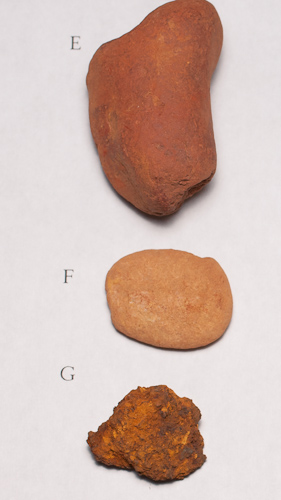
Ochres and earth pigments
Collected in Adiet, 2009
Painters make a variety of colours from stones and colored earths. After a rain, they will scour streams for strongly-colored ochre rocks, which then must be very finely ground and washed to make reds, oranges, and yellows. These stones were collected while walking with a painter and his apprentice in a streambed in the Adiet region of Tigray.

Samples
Magical Images
Qes Teubo, Lalibela, 2009
The image on the right side of the screen is a modern arrangement of a variety of magical images. This format, intended to hang on a wall, is not traditional, but the content of the images is: such images are often found on magical scrolls and amulets. Note the image of St. George as Dragonslayer for comparison with the other images on this page.
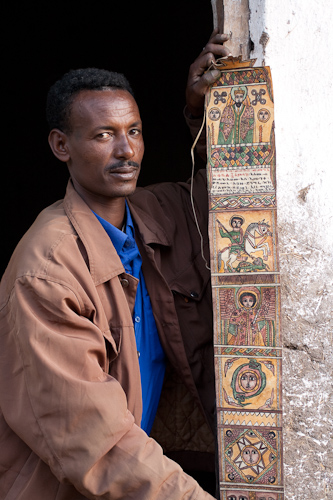
The artist and scribe, Qes (Priest, in Amharic) Te'ubo, at his home in Lalibela.
St. George and the Dragon
Keshi Gebre Kristos, Axum, 2009
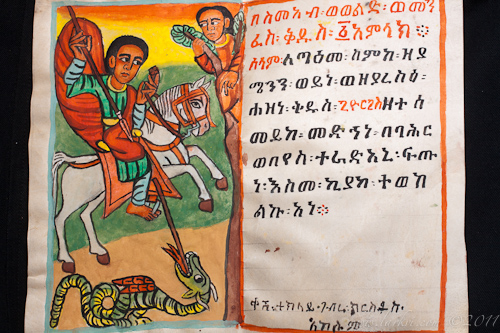
St. George is the patron Saint of Ethiopia, and the image of St. George as dragonslayer is a popular one in both a religious and magical context. In this writing sample, the scribe, also a painter, has chosen it to highlight his work. The writing in red on the facing page of text includes the invocation of the Trinity: በስመ፡አብ፡ወወልድ፡ወመንፈስ፡ቅዱስ፡፩አምላክ። ሰላም "In the name of the Father, the Son, and the Holy Spirit, One God. Peace" which traditionally starts religious works in Ethiopia and also the name of the saint the work is dedicated to, ጊዮርጊስ, Giyorgis--St. George.
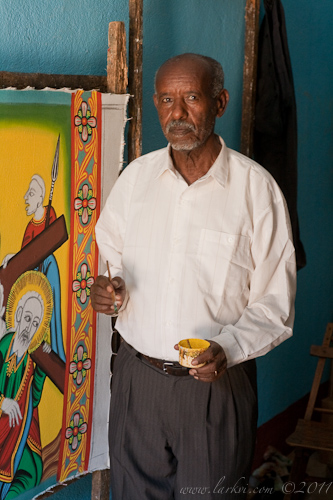
The artist and scribe, Keshi (Priest, in Tigrinya) Teklay GebreKristos, in his studio in Axum.
St. George and the Dragon
Aleka WoldeGabreal GebreTsadkan, Axum, 2009
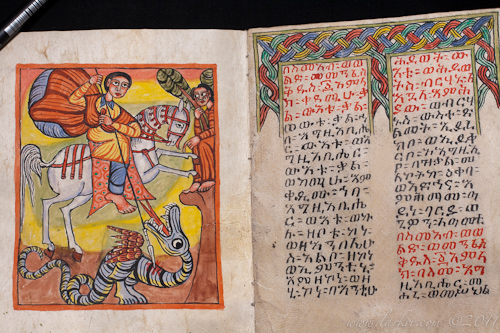
Aleka WoldeGabreal is working with the same theme and style, but in a more refined way. Note also the vinework "harag" which marks the beginning of the text, followed by several lines of red text spanning both columns, another way of marking openings and divisions within texts.

The artist and scribe, Aleka (denoting a man learned in Church lore) WoldeGebreal GebreTsadkan, pictured with an unfinished scroll.

